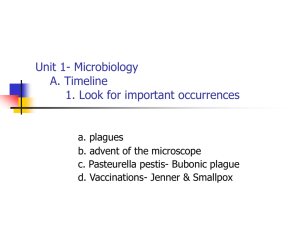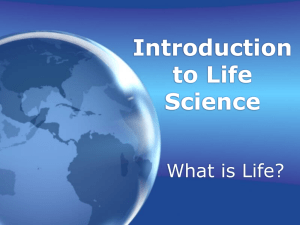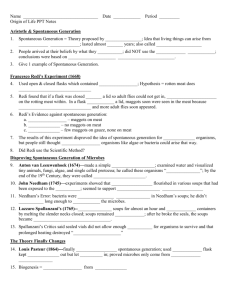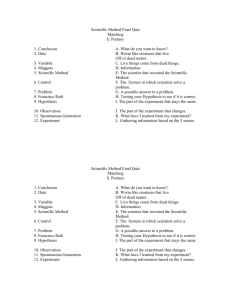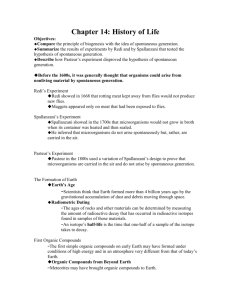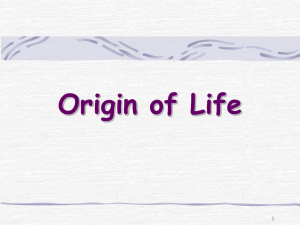The Cell Theory
advertisement
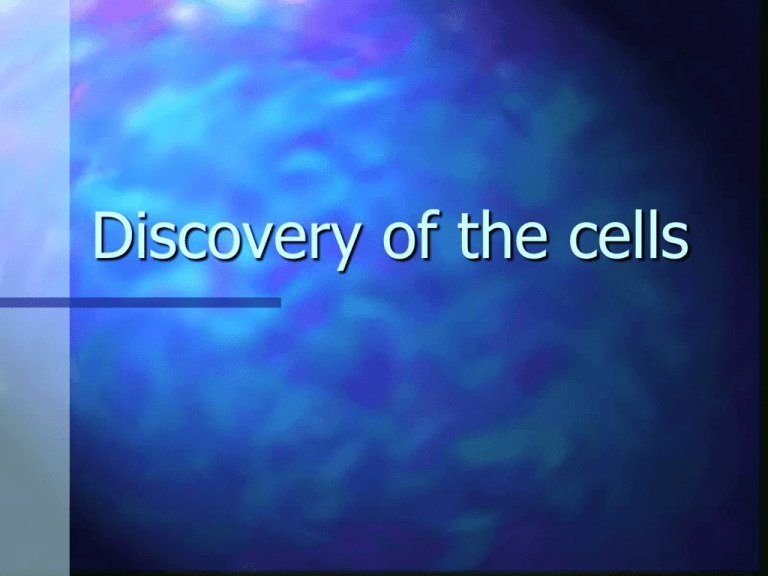
Discovery of the cells Some Random Cell Facts The average human being is composed of around 100 Trillion individual cells!!! It would take as many as 50 cells to cover the area of a dot on the letter “i” WOW!!! Previous to the Discovery of the cell… What was happening at that time? Spontaneous Generation For much of history, people believed that animals could come from non-living sources. They thought: Frogs developed from falling drops of rain mice and snakes came from hay barns and grain bins flies arose from decaying meat. This is called abiogenesis Also known as spontaneous generation These ideas were followed because people simply accepted what they were told The Power of Authority In the past, people believed what they were told by “authorities” such as the Church, or the ancient Greek philosopher Aristotle Questioning Aristotle was like questioning the Church.... Discovery of Cells 1665- English Scientist, Robert Hooke, discovered cells while looking at a thin slice of cork. He described the cells as tiny boxes or a honeycomb He thought that cells only existed in plants and fungi Anton van Leuwenhoek 1673- Used a handmade microscope to observe pond scum & discovered single-celled organisms He called them “animalcules” He also observed blood cells from fish, birds, frogs, dogs, and humans Therefore, it was known that cells are found in animals as well as plants HOW MANY YearS Gap??? Between the Hooke/Leuwenhoek discoveries and the mid 19th century, very little cell advancements were made. This is probably due to the widely accepted, traditional belief in Spontaneous Generation. Examples: -Mice from dirty clothes/corn husks -Maggots from rotting meat FRANCESCO REDI Italian doctor poet, Francesco Redi. In the mid-1600s, i designed a controlled experiment It took hundreds of years of experiments to convince people that spontaneous generation does not occur. 1668 -- Francisco Redi (Italian physician & poet)-attempted to disprove the theory of Spontaneous Generation. “The flesh of dead animals cannot engender worms unless the eggs of the living being deposited therein” Put dead snakes, eels, and veal in large wide mouthed vessels. Sealed one set with wax and left the other set open to air. Decaying meat was teeming with maggots, sealed meat had no maggots Wax sealed vessels failed to produce maggots because flies were unable to reach the meat Redi’s critics said: You have too many variables There is a lack of access and a lack of air. We ALL know that everything needs air Of course no flies grew! You haven’t proven anything. Redi part 2 – answer to critics fine mesh allows in air, but not flies flies laid eggs on top of mesh no maggots in meat Redi’s Conclusions: “All living beings come from seeds of the plants or animals themselves” However, if someone were to demonstrate even one exception to this hypothesis, then Redi’s hypothesis would be rejected. 19th Century Advancement Much doubt existed around Spontaneous Generation Conclusively disproved by Louis Pasteur Pasteur: Ummm, I don’t think so!!! ? = + LOUIS PASTEUR 1859 (French chemist) entered a contest sponsored by French Academy of Sciences to prove or disprove Spontaneous generation. used swan-necked flask flask allowed in air, but trapped dust (and microbes) boiled infusion showed that NO growth occurred, even after many days BUT -- what about damaging the “active principle”? Pasteur squashes the idea of abiogenesis completely! Since then, no one has been able to refute Pasteur’s experiment scientists everywhere soon came to accept that abiogenesis did NOT EXIST. but: then how did life on this planet start in the first place? The Cell Theory Development of Cell Theory 1838- German Botanist, Matthias Schleiden, concluded that all plant parts are made of cells 1839- German physiologist, Theodor Schwann, who was a close friend of Schleiden, stated that all animal tissues are composed of cells. Development of Cell Theory 1858- Rudolf Virchow, German physician, after extensive study of cellular pathology, concluded that cells must arise from preexisting cells. The Cell Theory Complete The 3 Basic Components of the Cell Theory were now complete: 1. All organisms are composed of one or more cells. (Schleiden & Schwann)(1838-39) 2. The cell is the basic unit of life in all living things. (Schleiden & Schwann)(1838-39) 3. All cells are produced by the division of preexisting cells. (Virchow)(1858) .1. All organisms are composed of one or more cells. 2. The cell is the basic unit of life in all living things. 3. All cells are produced by the division of preexisting cells. Can you imagine…donut’s are produced by the division of preexisting donuts! Modern Cell Theory Modern Cell Theory contains 4 statements, in addition to the original Cell Theory: The cell contains hereditary information(DNA) which is passed on from cell to cell during cell division. All cells are basically the same in chemical composition and metabolic activities. All basic chemical & physiological functions are carried out inside the cells.(movement, digestion,etc) Cell activity depends on the activities of sub-cellular structures within the cell(organelles, nucleus, plasma membrane) How Has The Cell Theory Been Used? The basic discovered truths about cells, listed in the Cell Theory, are the basis for things such as: Disease/Health/Medical Research and Cures(AIDS, Cancer, Vaccines, Cloning, Stem Cell Research, etc.) Some Parting Thoughts It is amazing to think that the cells that make up our bodies are just as alive as we are. Humans are just an intricately designed community of cells, which must work together to survive. Cells, in my opinion, are one of the strongest cases for intelligent design. Stem cells (embryonic stem cells) distinguished from other cell types by two important characteristics. First, they are unspecialized cells capable of renewing themselves through cell division, sometimes after long periods of inactivity. Second, under certain physiologic or experimental conditions, they can be induced to become tissue- or organ-specific cells with special functions. Professors Clones Dolly

